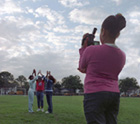
Desire: a film by Julie Gustafson with the Teenage Girls’ Documentary Project in New Orleans 2005
Distributed by Women Make Movies, 462 Broadway, New York, NY 10013; 212-925-0606
Produced by Julie Gustafson
Directed by Julie Gustafson
VHS, color, 84 min.
Sr. High - Adult
African American Studies, Social Work, Women's Studies
Date Entered: 05/01/2006
Reviewed by Barb Bergman, Minnesota State University, MankatoI have a confession to make. When I read in the description that Desire was filmed by the Teenage Girls’ Documentary Project, I cringed, picturing 84 minutes of home movies with handheld cameras.
Desire far surpassed my expectations. I found Desire to be an engaging look at five New Orleans teens and their families. Filmed over the course of five years, the five girls grow and mature. Nominal, the title comes from the Desire housing project in New Orleans’ 9th Ward – which has since been devastated by Hurricane Katrina – but the real desires are the girls’ hopes and dreams that they share through the camera. Desire spans race, ethnicity, and class: two of the five girls are African Americans living in a housing project, one is a poor white girl, and two are white upper middle-class girls attending private schools. None of their lives quite follow the paths they described when first interviewed: three become teenage mothers, one realizes that she is bisexual, one drops out of high school, and three become college students. Although the girls talk frankly about their thoughts on sex, sexuality is ultimately part of the bigger picture of decisions, goals, and responsibility. Desire presents a very real look into the lives of modern teenage girls.
One of the most interesting scenes occurs when Kimeca, a 17-year-old mother-of-two, turns the camera on the filmmaker. When Gustafson reveals that she had an abortion as a teenager, it is clear that Kimeca does not consider abortion as an acceptable option. By the end, I found that I still wanted to know more. Perhaps like the 7up series, we can learn more about these girls in a few years.
The technical aspects are good. The video neither feels like a home movie nor does it turn into a dry “talking heads” documentary.
The insights provided by Desire can be used at many levels. Highly recommended for high schools, colleges, and adults who deal with teens.